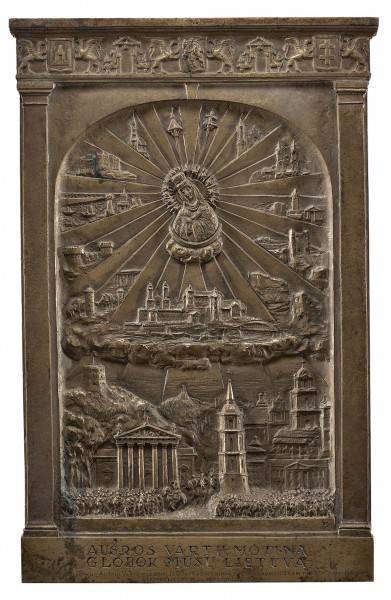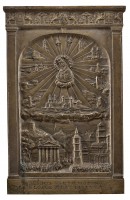
Mother of the Gates of Dawn, protect our Lithuania
| Author: |
Rapolas Jakimavičius (1893–1961)  |
| Created: | 1943 |
| Material: | copper alloy |
| Technique: | engraving, moulding |
| Dimensions: | 56 × 36.50 cm |
| Signature: | bottom inscription: AUŠROS VARTŲ MOTINA / GLOBOK MŪSŲ LIETUVĄ / KUN. PRANUI BIELIAUSKUI, AUŠROS VARTŲ KLEBONUI, JO 60 M. AMŽIAUS SUKAKČIAI IR VISUOMENIŠKAM DARBUI PAMINĖTI / DĖKINGI LIETUVIAI 1883-VIII.23 – 1943 |
Rapolas Jakimavičius (1893–1961) made the bas-relief Mother of the Gates of Dawn, protect our Lithuania in German-occupied Vilnius in 1943. He was born and grew up in Vilnius, attended the Vilnius School of Drawing, and studied sculpture at Stephen Báthory University after the First World War. He lived in the city during the interwar period, painted portraits, made tombstones and memorial plaques, designed monuments, and was a keen advocate of everything Lithuanian. During the difficult years of the Second World War, Lithuanian Catholic activists decided to place votive offerings in the Chapel of the Gates of Dawn, in order to put Lithuania under the protection of the miracle-working picture. Votive offerings are signs of prayers and tokens of gratitude, and represent a plea for divine mercy. The interior of the Chapel of the Gates of Dawn is covered with votive offerings: symbolic silver plates in the shape of parts of the body. The implementation of this particular idea was left to Jakimavičius. He wanted to make a huge silver two-by-one-metre bas-relief, but the German authorities would not allow him to make such work. Instead, he made a smaller replica of it in bronze, as a gift from the Lithuanian community in Vilnius to Fr Pranas Bieliauskas on his 60th birthday. An arch in the image of the Gates of Dawn frames the picture of The Blessed Virgin Mary, Mother of Mercy, with motifs of Lithuanian towns and wooden folk-style crosses between its rays. Below it is a view of Cathedral Square in Vilnius, surrounded by some well-known buildings. A historic event is taking place in the square: crowds of people welcome mounted Lithuanian soldiers entering Vilnius in 1939, when, according to a treaty with the Soviet Union, Vilnius was returned to Lithuania. Vilnius is shown in the bas-relief as the capital of Lithuania, as a Lithuanian and a Catholic city.
Text author Laima Laučkaitė
On 10 November 1943, prominent Lithuanians in Vilnius asked permission from Archbishop Mečislovas Reinys to place a large silver votive offering in gratitude to the Blessed Virgin Mary in the Chapel of the Gates of Dawn. Through it, they hoped to secure patronage for belligerent Lithuania, and to express the love and gratitude of the Lithuanian people for the famous picture: ‘Over centuries, Lithuanians adorned the Gates of Dawn with votive offerings without any inscriptions, or with inscriptions in foreign languages, as it was customary at that time […] the people of Lithuania would like to make a votive offering to express to Our Lady their gratitude and love, and reflect the most beautiful moments in the life of our people, and our national self-determination.’ A votive plaque in the form of a relief was commissioned from the sculptor Rapolas Jakimavičius (1843–1961), who provided a sketch for it. The idea did not materialise due to the war. The sculptor cast a smaller copper plaque to the same design, and dedicated it to Pranas Bieliauskas, the parish priest at the Gates of Dawn between 1940 and 1944 and a famous public figure in the Vilnius district, who fostered the Lithuanian spirit and traditions, and collected items of folklore.
Text author Dalia Vasiliūnienė
The bas-relief Our Lady of the Gates of Dawn, protect our Lithuania made by Rapolas Jakimavičius (1893–1961) during the war shows a view of Cathedral Square full of people welcoming the Lithuanian army entering Vilnius in 1939. The Virgin Mary appears surrounded by architectural features from different Lithuanian cities. It was a symbolic way of putting this iconic image of Vilnius in a Lithuanian context.
Text authors Dovilė Barcytė and Ieva Burbaitė
Source: Law firm Valiunas Ellex art album VILNIUS. TOPOPHILIA I (2014). Compiler and author Laima Laučkaitė, HEAVEN AND BEYOND (2016). Compiler Dalia Vasiliūnienė. Text authors Dalia Vasiliūnienė, Skaidrė Urbonienė, KAUNAS–VILNIUS / 1918–1945 (2021). Compilers and text authors Dovilė Barcytė and Ieva BurbaitėExpositions: “Heaven and Beyond. Works of religious art from the collection of Rolandas Valiūnas and the law firm Valiunas Ellex“, 31 May–24 September 2016, Church Heritage Museum, Vilnius (curators Dalia Vasiliūnienė, Skaidrė Urbonienė); “Vilnius. Topophilia. Views of Vilnius from the collection of the law firm Ellex Valiunas”, 5 October – 26 November 2017, National Gallery of Art, Vilnius (curator Laima Laučkaitė); "1918-1945 / Kaunas-Vilnius", 27 August 2020 – 21 August 2021, Lithuanian Art Centre TARTLE (Užupio St. 40, Vilnius). Curators Dovilė Barcytė and Ieva Burbaitė.







